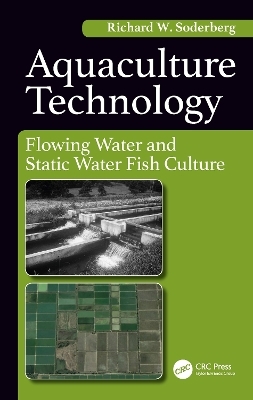
Aquaculture Technology
Flowing Water and Static Water Fish Culture
Seiten
2017
Crc Press Inc (Verlag)
978-1-4987-9884-6 (ISBN)
Crc Press Inc (Verlag)
978-1-4987-9884-6 (ISBN)
This will be the first book to provide the skills to raise fish in both a static water and a flowing water aquaculture system with a pragmatic and quantitative approach.
Key features:
Takes a quantitative approach to the science of aquaculture
Covers the complete landscape of the scientific basis of fish culture
Promotes problem solving and critical thinking
Includes sample problems at the end of most chapters
Guides the reader through the technical considerations of intensive aquaculture, including fish growth rates, hydraulic characteristics of fish rearing units, oxygen consumption rates in relation to oxygen solubility and fish tolerance of hypoxia, and water reconditioning by reaeration and ammonia filtration.
Discusses the environmental effects of aquaculture
Includes a chapter on hatchery effluent control to meet receiving water discharge criteria
Aquaculture Technology: Flowing Water and Static Water Fish Culture is the first book to provide the skills to raise fish in both a flowing water and a static water aquaculture system with a pragmatic and quantitative approach. Following in the tradition of the author’s highly praised book, Flowing Water Fish Culture, this work will stand out as one that makes the reader understand the theory of each type of aquaculture system; it will teach the user "how to think" rather than "what to think" about these systems.
The book presents the scientific basis for the controlled husbandry of fish, whether it be in a stream of water or a standing water pool. Part 1, Flowing Water Fish Culture, is a major revision of the author’s initial book and includes greatly expanded coverage of rearing unit design criteria, fish growth and the use of liquid oxygen, hatchery effluent control, and recirculating systems. Part 2, Static Water Fish Culture, presents the scientific basis of fish culture in standing water systems including nutrient and dissolved gas dynamics, pond ecology, effects of fertilization and supplemental feeding, water quality management and representative static water aquacultures.
Aquaculture Technology conveys the science in a manner appropriate for use by university students and teachers and others involved in fish production and aquaculture research and development worldwide. It will enable the reader to adapt to changing technologies, markets, and environmental regulations as they occur.
Key features:
Takes a quantitative approach to the science of aquaculture
Covers the complete landscape of the scientific basis of fish culture
Promotes problem solving and critical thinking
Includes sample problems at the end of most chapters
Guides the reader through the technical considerations of intensive aquaculture, including fish growth rates, hydraulic characteristics of fish rearing units, oxygen consumption rates in relation to oxygen solubility and fish tolerance of hypoxia, and water reconditioning by reaeration and ammonia filtration.
Discusses the environmental effects of aquaculture
Includes a chapter on hatchery effluent control to meet receiving water discharge criteria
Aquaculture Technology: Flowing Water and Static Water Fish Culture is the first book to provide the skills to raise fish in both a flowing water and a static water aquaculture system with a pragmatic and quantitative approach. Following in the tradition of the author’s highly praised book, Flowing Water Fish Culture, this work will stand out as one that makes the reader understand the theory of each type of aquaculture system; it will teach the user "how to think" rather than "what to think" about these systems.
The book presents the scientific basis for the controlled husbandry of fish, whether it be in a stream of water or a standing water pool. Part 1, Flowing Water Fish Culture, is a major revision of the author’s initial book and includes greatly expanded coverage of rearing unit design criteria, fish growth and the use of liquid oxygen, hatchery effluent control, and recirculating systems. Part 2, Static Water Fish Culture, presents the scientific basis of fish culture in standing water systems including nutrient and dissolved gas dynamics, pond ecology, effects of fertilization and supplemental feeding, water quality management and representative static water aquacultures.
Aquaculture Technology conveys the science in a manner appropriate for use by university students and teachers and others involved in fish production and aquaculture research and development worldwide. It will enable the reader to adapt to changing technologies, markets, and environmental regulations as they occur.
Richard W. Soderberg
Preface. Flowing Water Aquaculture. Flowing Water Fish Culture. Fish Growth in Hatcheries. Water Sources for Flowing Water Fish Culture. Fish Culture Rearing Units. The Solubility of Oxygen in Water. The Oxygen Requirements of Fish. Rearing Density and Carrying Capacity. Reaeration of Flowing Water. Ammonia Production and Toxicity. Fish Hatchery Effluent Control. Water Recirculation. Static Water Aquaculture. Static Water Fish Culture. Review of Limnology. Principles of Static Water Aquaculture. Ecology of Static Water Aquaculture. Photosynthesis and Respiration. The Carbon Cycle, Alkalinity and Liming. Nutrient Cycles and Fertilization. Use of Artificial Diets in Static Water Aquaculture.
| Erscheinungsdatum | 12.07.2017 |
|---|---|
| Zusatzinfo | 42 Tables, black and white; 82 Illustrations, black and white |
| Verlagsort | Bosa Roca |
| Sprache | englisch |
| Maße | 156 x 234 mm |
| Gewicht | 566 g |
| Themenwelt | Technik ► Lebensmitteltechnologie |
| Weitere Fachgebiete ► Land- / Forstwirtschaft / Fischerei | |
| ISBN-10 | 1-4987-9884-5 / 1498798845 |
| ISBN-13 | 978-1-4987-9884-6 / 9781498798846 |
| Zustand | Neuware |
| Haben Sie eine Frage zum Produkt? |
Mehr entdecken
aus dem Bereich
aus dem Bereich
Technologie, Chemie, Mikrobiologie, Analytik, Bedeutung, Recht
Buch | Hardcover (2023)
Verlag Eugen Ulmer
CHF 169,00


